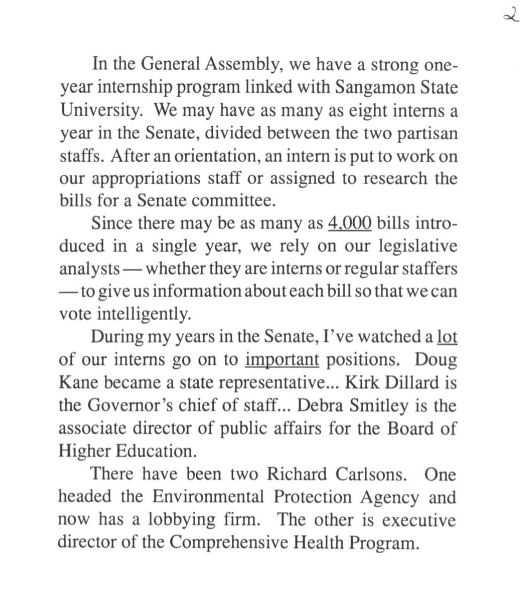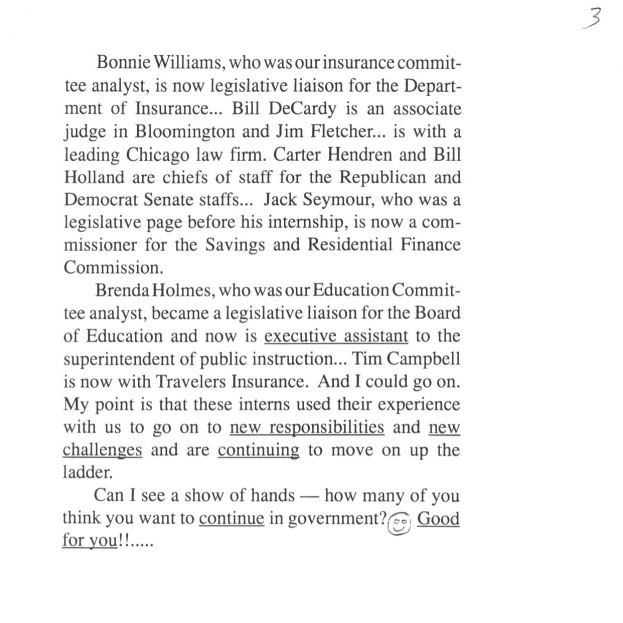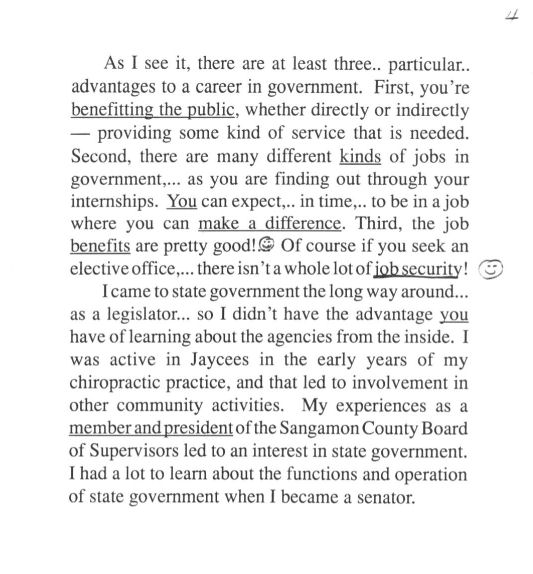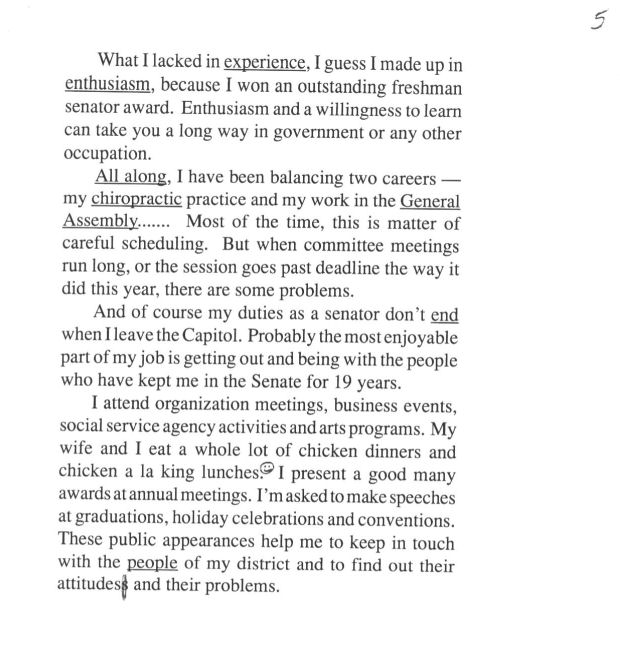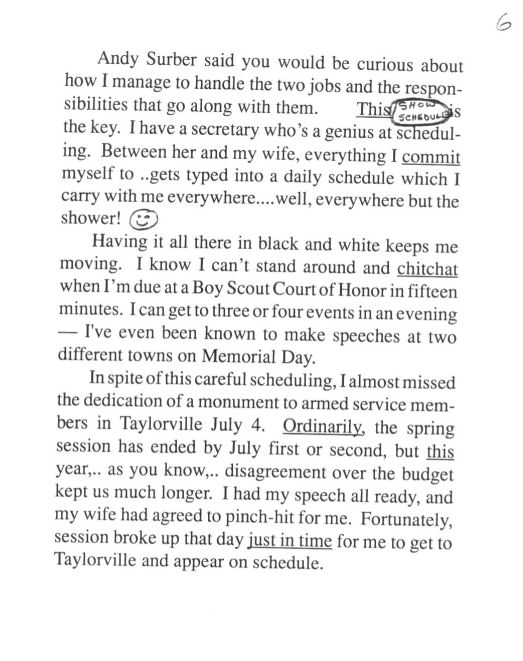speeches
As a news writer for the Republican office of the State Senate, Carolyn had occasion to write speeches for a number of state senators. We've preserved two of them here for you. The first is a special favorite.Senator David N. Barkhausen
It is a pleasure to be with you today and to have the opportunity to talk about the document that touches our lives in so many ways each day — the United States Constitution. Like you, I have always had a great interest in and admiration for our Constitution, and actually enjoyed studying it from grade school through law school.
Never before, however, have I had a chance to share my enthusiasm for the Constitution, let alone with a group with as strong an interest in its history as yours. Although the contents of the Constitution were the subject of heated and lively meetings and dinner table conversations 200 years ago, I suspect most organizations — and party hosts and hostesses — would have difficulty if they proposed it as a subject for discussion today.
So it is a particular pleasure to talk about it with an organization whose members can trace their love of country back to the time that our Constitution was written. You and your forebears have worked hard down through the years to preserve this remarkable document and the great nation that has developed from it.
We all studied the Constitution and the Declaration of Independence — perhaps reluctantly — when we were youngsters. But most people often confuse the two documents or think that the Constitution was framed along with the Declaration. In fact, the Declaration penned by Thomas Jefferson was approved by the Continental Congress in 1776, but it was 11 years later that a Constitutional Convention met in Philadelphia to create the amazing document that has become a framework for democratic government and constitutional rights throughout the world.
Of course, the United States was not without a government in those intervening years. Preceding the Constitution was the Articles of Confederation, an unwieldy and unenforceable plan that became the law of the land in 1781. It was unwieldy because none of the powers it gave to Congress could be exercised without approval of nine of the 13 states that made up this nation. And many of the states were more concerned about their own rights than about forming a nation.
That a 55-man body of patriots roughly the size of our 59member Illinois Senate could design such a masterful and innovative plan of government should be a source of wonderment and pride to us all — especially those of us familiar with the operation of the Illinois General Assembly.
As a legislator, I see every year the lengthy battles that can take place over even an innocuous and obscure law. And two years later, we may be back amending that law, changing the wording or the provisions, because we didn't get it right the first time. How did those 55 men who met in steamy Philadelphia during the summer of 1787 manage to produce a workable plan that has now stood for more than two centuries, needing only 26 amendments in all that time?
It wasn't accomplished in a day, or a week, or a month. The convention began its monumental task in May, with delegates including George Washington and James Madison pushing for a genuinely national government with the powers to promote the security, financial stability, commercial prosperity and general wellbeing of states of the nation. Then there was a states' rights bloc, firmly opposed to the creation of a sovereign national government and preferring a looser confederation-of-states type of government.
There was a New Jersey plan and then a Virginia plan. The ultimate solution was the Connecticut compromise, which provided for the lower house of Congress to be apportioned according to population, for each state to be equally represented in the upper house, and for the President to be selected by an electoral college. "In one branch, the people ought to be represented," Dr. Johnson of Connecticut told the convention. "In the other, the states." In mid-September, the convention somehow put its various resolutions and decisions into a final draft and submitted it to the states for approval. And to think they did all this without computers, copy machines or telephones, and in a place without air conditioning! I have no doubt that the conclusion of our legislative sessions in Springfield — and for that matter, of Congressional sessions in Washington — would come much more quickly without air conditioning.
The most controversial spokesman at the convention was Alexander Hamilton, a New York lawyer and banker who favored a strong central government. At one point, he walked out in anger after fellow delegates had accused him of trying to set up an American monarchy. Many delegates agreed that the existing Congress had been impotent, but they were shocked when Hamilton said, "The people are gradually ripening in their opinion of government. They begin to be tired of an excess of democracy."
Richard Henry Lee of Virginia didn't agree with that notion. He complained that the proposed Constitution was "a transfer of power from the many to the few." James Winthrop of Massachusetts concurred. In a series of letters, he said the transfer of power from the states to the federal system would create a permanent aristocracy. George Mason, author of Virginia's Declaration of Rights, claimed that his state document would be rendered useless by the Constitution. And in Baltimore, Luther Martin predicted that the federal form of government would eventually become too expensive.
In the end, the document was the product of many compromises. Many delegates gave a little, and some gave a lot.
Alexander Hamilton said that no delegate's ideas were more remote from the final document than his own, but he conceded graciously that the convention had taken the appropriate steps to avoid anarchy and convulsion. Benjamin Franklin also admitted to reservations about it, but he said, "The older I grow, the more apt I am to doubt my own judgment and pay more respect to the judgment of others." Many Southerners feared they would suffer a competitive disadvantage under the Constitution, but James Madison urged them not to be short-sighted. "As we are laying the foundation for a great empire, we ought to take a permanent view of the subject.
I think we can say, after more than 200 years, that the framers did, indeed, take a permanent view. Isn't it astonishing that a design intended for a small nation of less than 4 million people in 13 largely-agricultural states could be equally effective two centuries later for an industrial nation of 50 states with a population of 248 million?
The Constitution was ratified by 12 of the states in 1788, with Rhode Island holding off until 1790. Even after ratification, controversy over the Constitution continued. In Pennsylvania, for example, many anti-Federalists were farmers who spoke acidly of the Federalists' commercial interests. "They expect to be the manager of this Constitution, and get all the power and all the money into their own hands," said Amos Singletary, "and then they will swallow up all of us little folks like the great Leviathan."
The framers of the Constitution stated clearly that its purpose was to form a more perfect Union, establish Justice, insure domestic Tranquility, provide for the common defense, promote the general Welfare, and secure the blessings of Liberty to ourselves and Our Posterity.
The text of the Constitution, itself, takes up only about six pages in modem reference books. One can only marvel at the brevity and succinctness of the document, created at a time when most writings tended to be flowery and verbose. It defines the legislative branch and the election, duties and powers of the members of Congress. It spells out the responsibilities of the President and the executive branch. Next, it establishes the judicial branch. It goes on to delineate the taxing structure for the nation.
At the Constitutional Convention, there was considerable pressure for a Bill of Rights. George Mason of Virginia proposed that the Constitution be prefaced with such provisions as he and Patrick Henry had championed in the Virginia Bill of Rights, but his motion lost. When the Constitution came up for ratification, its opponents also stressed the need for a bill of rights. In consequence, the states sent along with their ratification more than a hundred amendments they wanted adopted by the new government.
So in 1789, the new U.S. House of Representatives proposed 17 amendments and sent them to the equally-new Senate, which whittled them down to 12. Two of those failed ratification, but the 10 that make up the first 10 amendments — the Bill of Rights -provide for freedom of religion, speech and assembly and the right of petition. They guarantee against unreasonable searches and seizures, prohibit double jeopardy, coerced testimony against oneself and depriving any person of life, liberty or property without due process of law.
They prevent taking of private property for public use without compensation, provide the right for a speedy and public trial, the right to be confronted by accusing witnesses, the right to assistance by counsel and the right to trial by jury. They prohibit excessive bail or fines and cruel and unusual punishment. And they do all this in some 400 words!
The 10 amendments became law near the end of 1791, when Virginia became the tenth state to ratify them. By that time, Vermont had been admitted as the 14th state in the Union. Kentucky followed in 1792, the year the cornerstone was laid for what was to be the Presidential Palace (the White House) in the new federal city, located in what was then called the Territory of Columbia.
In the ensuing 200 years, our Constitution was amended only 16 times more. Best-known among these additions are the 13th, which prohibits slavery; the 14th, which prohibits states from infringing upon due process rights; the 15th, granting universal suffrage to males; the 16th, permitting income taxes; the 18th, prohibition of intoxicating liquors; the 19th, granting the vote to women; the 21 st, repealing prohibition; the 22nd, limiting Presidents to two elected terms; and the 26th, giving 18-year-olds the right to vote.
Every American can take great pride in our Constitution, even though we still argue about the meaning of some of its provisions. It helped us to survive a Civil War that threatened to tear our nation apart. It has carried us through other major wars, civil strife, a Great Depression, assassinations of Presidents, and periods of unrest when burning the flag has been almost more popular than saluting it. No doubt the United States will continue to have its good times and its bad times, but with the Constitution behind us, and with organizations like yours to help maintain our sense of nationhood, the United States of America will continue to serve as a model and beacon for freedom-loving people everywhere.
Scan of a original copy for Senator John A. Davidson

